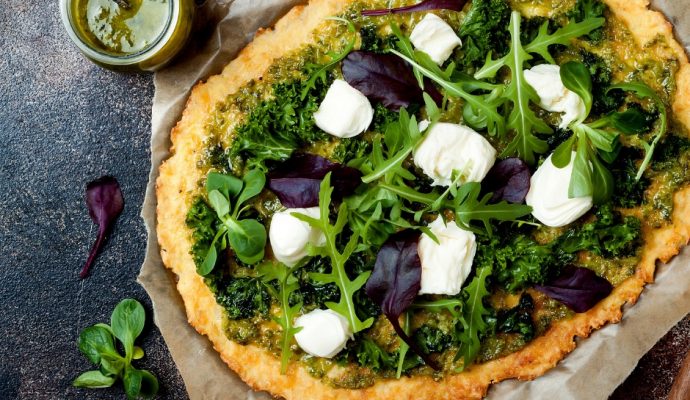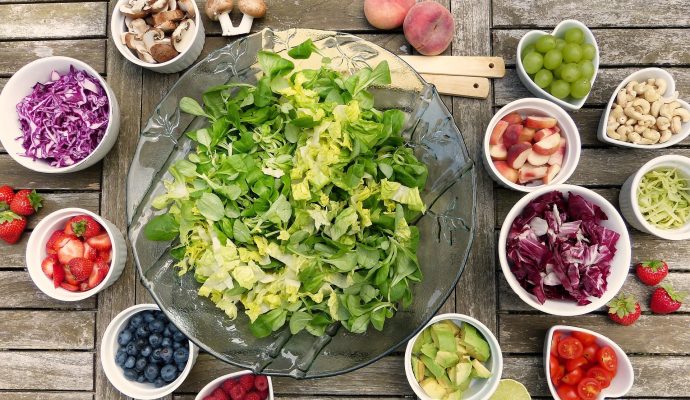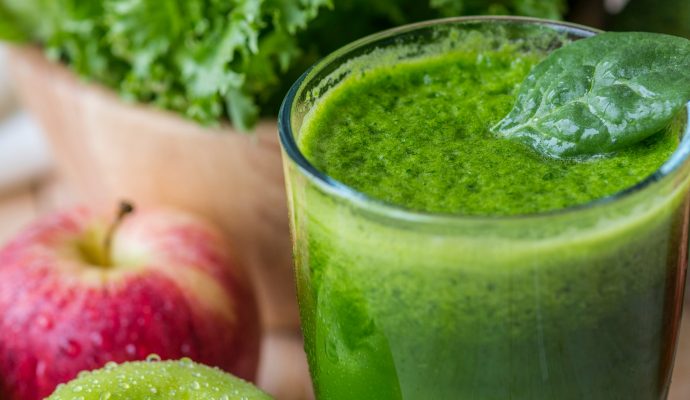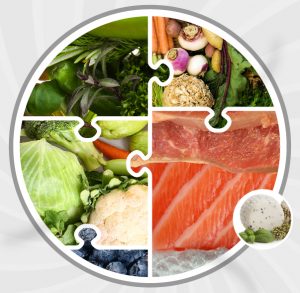Do we really need to worry about what we eat?
These days, more and more people are telling us that healthy eating is very important for our health and well being. However, is it really all that important? A human being is made up of roughly 63% water, 22% protein, 13% fat and 2 % minerals and vitamins (Holford 2005). Every single molecule comes from the food you eat and the water you drink. Eating the highest-quality food, in the right quantities, can help you to achieve your highest potential for health, vitality and freedom from disease. For example, there is good evidence that eating a healthy diet can reduce your risk of obesity and illnesses such as diabetes, heart disease, stroke, osteoporosis and some types of cancer, including those of the bowel, stomach, mouth, and breast (Cancer Research UK 2009).
But eating healthily doesn’t just reduce your risk of ill health, it will also help boost your energy levels, mood, concentration and help you handle stress better, making you feel better all round.
How have our diets and lifestyles changed?
Although we are living in the 21st century, our human genome is greater than 10,000 years old. The genome refers to our entire DNA, including our genes. Genes carry information for making all the proteins required by the body. These proteins determine, among other things, how well the body metabolises food or fights infection, and sometimes even how it behaves. Our ancestors consumed only natural and unprocessed food from the environment which provided them with a diet of moderate protein, high in fibre, vitamins, minerals, antioxidants and other beneficial plant chemicals. Thus, many researchers argue that there is a striking discrepancy between the diet we were biologically designed to eat and what we actually eat today.
Rapid changes in diets and lifestyles have occurred with industrialisation, urbanisation, economic development and market globalisation. While standards of living have improved, food availability has expanded and become more diversified, there have also been significant negative consequences in terms of inappropriate dietary patterns, decreased physical activities and increased tobacco use. This has corresponded with an increase in diet-related chronic diseases which are becoming increasingly significant causes of disability and premature death. For example, traditional, largely plant based diets have been replaced by an emphasis on animal-based foods and energy-dense diets which are high in fat- particularly saturated fat, and low in complex carbohydrates. Alongside this shift in dietary patterns, we have also switched to a much more sedentary lifestyle due to motorised transport, labour-saving devices in the home, the phasing out of physically demanding manual tasks in the workplace, and leisure time that is predominantly devoted to physically undemanding pastimes (World Health Organisation 2003).
Can nutrition help prevent disease?
It has been calculated that, in 2001, chronic diseases contributed to approximately 60% of the 56.5 million total reported deaths in the world and to approximately 46% of the global burden of disease- this is expected to increase to 57% by 2020(World Health Organisation 2003).
Chronic diseases are largely preventable diseases (World Health Organisation 2003). Although more basic research may be needed on some aspects of the mechanisms that link diet to health, the currently available scientific evidence provides a sufficiently strong and plausible basis to justify taking action now (World Health Organisation 2003). Modern dietary patterns and physical activity patterns are risk modifiable behaviours. Furthermore, nutrition has been shown to have the capacity to modify the expression of critical genes associated with normal physiological processes, as well as those associated with the development of disease, including age-related processes and cancer (Choi & Friso 2010). But diet, while critical to prevention, is just one risk factor. Physical inactivity, is now recognized as an increasingly important determinant of health, and is the result of a progressive shift of lifestyle towards more sedentary patterns.
What should we be eating?
There is no single “diet” which suits everyone-one man’s elixir could be another’s poison. However, there are some basics which apply to us all. Most people in the UK eat and drink too many calories, and too much fat, sugar and salt, and not enough fruit, vegetables and fibre.
Increase Fruits & Vegetables
It has been estimated that eating at least 5 portions of a variety of fruit and vegetables a day could reduce the risk of deaths from chronic diseases such as heart disease, stroke, and cancer by up to 20% (Department of Health 2000). But eating fruit and vegetables can help to achieve other dietary goals too, including increasing fibre intake, reducing fat intake, helping to maintain a healthy weight, and displacing foods with added sugars.
The reason why fruit and vegetables are so beneficial is because as well as containing fibre, vitamins and minerals, fruit and vegetables also contain many complex plant components called phytochemicals. Phytochemicals are nonessential nutrients, meaning that they are not required by the human body for sustaining life, but they have protective or disease preventative properties. It is well-known that plants produce these chemicals to protect themselves but recent research demonstrates that they can also protect humans against diseases.
How many fruits and vegetables do we need?
The UK government recommends that we have AT LEAST 5 portions (400g) of a variety of fruit and vegetables daily, 2 of fruit and 3 of vegetables.
One portion of fruit:
- half a large grapefruit
- a slice of melon
- 2 satsumas
- 3 dried apricots, or 1 tablespoon of raisins
- A glass of 100% juice- but you can only count juice as 1 portion a day, however much you drink. This is because it has very little fibre.
One portion of vegetables:
- 3 tablespoonfuls of cooked carrots or peas or sweet corn
- 1 cereal bowl of mixed salad.
- Beans and other pulses, such as kidney beans, lentils and chick peas, count only once a day, however much you eat. While pulses contain fibre and protein, they don’t give the same mixture of vitamins, minerals and other nutrients as fruit and vegetables.
- Potatoes don’t count towards 5 A DAY because they are starchy
Increase healthy fats
Eating too much fat can make us more likely to put on weight, because foods that are high in fat are also high in energy (calories). Being overweight raises our risk of serious health problems. However, this doesn’t mean that all fat is bad. We need some fat in our diet because it helps the body absorb certain nutrients, provides energy and essential fatty acids that the body can’t make itself.
Reading nutrition labels on food packaging can help you to reduce the amount of fat you eat:
• High fat foods: more than 20g of total fat per 100g
• Low fat foods: less than 3g of total fat per 100g
Reduce Saturated fats
There are two main types of fat found in food: saturated and unsaturated. Saturated and unsaturated fat contain the same amount of calories, but most people in the UK eat too much saturated fat: about 20% more than the recommended maximum. Eating a diet high in saturated fat can cause the level of cholesterol in your blood to build up over time which can increase your risk of heart disease. The main sources of saturated fat are meat and dairy products.
- The average man should eat no more than 30g of saturated fat a day.
- The average woman should eat no more than 20g of saturated fat a day.
Look out for “saturates” or “sat fat” on the label: this tells you how much saturated fat is in the food.
- High: more than 5g saturates per 100g. May display a red traffic light.
- Low: 1.5g saturates or less per 100g. May display a green traffic light.
Unsaturated fats
There are also 2 kinds of unsaturated fats: monounsaturated fats which are found in olive oil and avocados, and polyunsaturated fats called omega-3 and omega-6 which are found in nuts, seeds and oily fish.
Omega-3 and omega-6 polyunsaturated fats are essential for optimal functioning of the brain and nervous system, immune system, cardiovascular system and skin health. Pumpkin and flaxseeds as well as oily fish (including salmon, mackerel, trout, herring, fresh tuna, sardines and pilchards) are rich in omega- 3 fats, while sesame and sunflower seeds are rich in omega-6 fats.
We should aim to eat a small handful of a combination of seeds and nuts daily, as well as eat at least one portion of oily fish weekly. In addition, by increasing our intake of plant foods, as opposed to animal foods, we naturally shift to a more healthy fat consumption.
Avoid hydrogenated and Trans fats
Trans fats are formed when manufacturers turn liquid oils into solid fats. Think shortening and hard margarine. Manufacturers create trans fats via a process called hydrogenation, a process by which vegetable oils are converted to solid fats simply by adding hydrogen atoms. Why hydrogenate? Because hydrogenation increases the shelf life and flavour stability of foods. Indeed, trans fats can be found in vegetable shortening, margarine, crackers, cereals, candies, baked goods, granola bars, chips, salad dressings, fried foods, and many other processed foods.
Like saturated fats, trans fats can raise cholesterol levels in the blood. This is why it’s recommended that trans fats should make up no more than 2% of the energy (calories) we get from our diet. For adults, this is no more than about 5g a day.
Increase fibre
Fibre is the structural part of a plant that supports and holds it together. Fibre can be chewed, swallowed and subjected to stomach acid, yet much of it passes through the body unchanged.
Fibre is important because it:
- stimulates the digestive tract and helps it work efficiently
- encourages the presence of health-giving bacteria in the large intestine
- softens the stool (bowel motion) and helps prevent constipation
- slows down carbohydrate absorption, makes you feel fuller and so helps to control your appetite, and therefore helps with weight management
- has also been associated with a decreased incidence of certain cancers of the digestive tract.
There are two types of fibre:
- Insoluble fibre– insoluble fibre is less easily broken down by bacteria in the colon, so it passes through the gut, helping other food and waste products move through the gut more easily. It holds water very effectively (up to 15 times its weight in water) thus contributing to an increase in stool weight. Fruit and vegetables with their skins and pips, wholegrain cereals (wheat, quinoa, rye, rice) as well as nuts and some pulses are good sources of this kind of fibre.
- Soluble fibre-this fibre forms a gel-like substance which can bind to other substances in the gut. It also has the extra benefits of lowering cholesterol levels and slowing down the entry of glucose into the blood, thereby helping to maintain good energy levels, concentration and mood. Fruits, vegetables, oats and pulses are good sources.
How much fibre do I need?
The recommended intake of fibre for adults in the UK is 18g a day, but 20 g -35 g in the US. However, most people in the UK don’t eat enough – the average intake is 12.6g a day for women and 15.2g a day for men.
So what does 18g of fibre look like? A few examples of the amount of fibre in some common foods include the following.
- One bowl (30g) of high-fibre cereal, e.g. bran flakes – 4g
- One slice of wholemeal bread – 3 to 4g (white bread contains less than half this amount)
- One baked potato (with skin) – 5g
- Half a tin of baked beans (200g) – 7.7g
- Portion of dried figs (50g) – 3.8g
- One medium-sized apple – 1.8g
Don’t forget the fluid
Without fluid, dietary fibre cannot do its job. Insoluble fibre, in particular, acts like a sponge absorbing water, increasing stool weight and size, thus putting pressure on the bowel wall and facilitating the movement of the stool. Without fluid this fibre is pointless and will only result in constipation.
Water
Two-thirds of the body consists of water and the body loses 1.5 Litres of water a day through the skin, lungs and gut and via the kidneys as urine, ensuring that toxic substances are eliminated from the body(Holford 2005). We also make about a third of a litre of water a day when glucose is “burned” for energy. So our minimum water intake from food and drink needs to be more than 1 litre a day, with the ideal begin around 2 litres daily. Fruit and vegetables consist of around 90% water- 4 pieces of fruit and four servings of vegetables can provide a litre of water, leaving 1 litre to be taken as water or diluted juices or herb or fruit teas. Alcohol acts as a diuretic and causes considerable losses of vitamins and minerals so it doesn’t count in this regard.
Should we be eating less?
We need to eat the right number of calories for our level of activity, so that we balance the energy we consume with the energy we use. Although consideration of calorie intake on its own is a simplistic view of weight management (and therefore also health management) if you eat or drink too much, you’ll put on weight. Likewise, if you eat too little for your energy requirements you’ll lose weight. The average man needs around 2,500 calories a day. The average woman needs 2,000 calories. Most adults are eating more calories than they need, and should eat fewer calories.
In fact, controlled, supervised calorie restriction is widely viewed as the most potent dietary means of slowing the aging process (Fontana et al 2004; Colman et al 2009). Calorie restriction is a dietary regimen that restricts calorie intake, where nutrient dense, low-calorie foods are consumed to supply sufficient quantities of vitamins, minerals and other important nutrients. Generally, a calorie-restriction diet may call for 20 to 30 percent fewer calories than usual. Adult-onset calorie-restriction works best when it is imposed slowly, over two or three years, to allow the body to adjust.
How should we be eating?
We should always eat in a way which helps us maintain steady blood sugar levels. Why? Food is turned into glucose or sugar, which is the fuel that drives all cells and bodily processes. Thus, maintaining a steady supply of glucose to cells is key for optimal mental and physical functioning. However, blood sugar levels must be kept within strict boundaries, since too much is toxic to cells on the one hand, and too little makes us feel tired and lethargic on the other. This balancing process happens through the actions of two hormones. Firstly, insulin stimulates cells to take in glucose when there’s too much of it in the blood- this helps lower high blood sugar levels, but also provides cells with the fuel they need. Secondly, another hormone called glucagon breaks down stored sugar when blood sugar levels are low.
The negative effects of imbalanced blood sugar levels include irritability, poor concentration, fatigue, depression and food cravings- especially for sweet foods or stimulants such as tea, coffee and cigarettes, all of which in turn cause further blood sugar roller coasters.
How you can maintain steady blood sugar levels
1. Eat breakfast. The meaning of the word “breakfast” is literally “breaking the fast”. Blood sugar levels are low after an overnight fast and skipping breakfast will result in an inadequate supply of glucose to the cells. This can make you feel fatigued, moody and affect your concentration.
2. Don’t skip meals. This is for the same reason you shouldn’t skip breakfast- it will lead to low blood sugar.
3. Choose complex carbohydrates. Complex carbohydrates are broken down more slowly into glucose because of their fibre content and therefore provide a steady supply of fuel to brain cells. Complex carbohydrates are found in whole grains, nuts, seeds, legumes, and vegetables.
4. Avoid refined carbohydrates. They convert more quickly into glucose than complex carbohydrates. This causes rapid blood sugar spikes, which is then followed by blood sugar lows because the body keeps blood sugar levels within a narrow range to protect against the potentially toxic effects of sugar on cells. This rapid drop in blood glucose levels (below the optimal reference range) starves the brain of its primary fuel and we experience symptoms such as energy slumps, cravings for sweets and stimulants (tea, coffee, and cigarettes), irritability, mood swings, poor memory, poor concentration and fuzzy thinking.
Refined carbohydrates are found in white pasta/bread/rice (as opposed to their whole grain versions) and anything containing added sugar like cakes, sweets, ice cream etc. Natural sugars are found in fruit and are better sources of simple carbohydrates because they contain protective antioxidants as well as fibre, which slows down the release of fruit sugar into blood and so reduces blood sugar spikes.
5. Avoid stimulants such as coffee, chocolate and nicotine which increase levels of the stress hormones cortisol and adrenaline (Lovallo et al 2006) which sharply spike up blood sugar levels and subsequently leads to an energy slump as described above. Adrenaline and cortisol are “fight-or-flight” hormones, biologically evolved to help survival under stressful situations by breaking down stored sugar to heighten alertness and fuel muscles for emergencies. However, unless the extra sugar released in the blood stream is burned off through a physical response as in the “fight-or-flight” reaction in a genuine emergency, blood sugar levels will remain high. This will trigger a large insulin response and lead to low blood sugar levels because the body keeps blood sugar levels within a narrow range to protect against the potentially toxic effects of sugar. Usually this results in reaching for another cup of coffee or more chocolate and the blood sugar roller coaster starts over. When stimulants are consumed, blood sugar levels remain high because the “fight-or-flight” reaction has been artificially induced rather than through a genuine emergency and requires no physical “fight-or-flight” response which would use up the extra blood sugar and naturally lower blood sugar levels to safe ranges.
6. Make sure you consume protein with each meal and snack – this helps slow down the release of sugar from food into the blood. Choose from chicken and turkey, game, white fish, oily fish (tuna, mackerel, herrings, pilchards, sardines, and salmon), pulses, eggs, yoghurt, cottage cheese, feta, nuts and seeds.
How do you make healthy eating a habit?
- Don’t try to change everything at once.
- Set an easy goal you can reach, like having a salad and a piece of fruit each day.
- Make a long-term goal too, such as having one vegetarian dinner a week.
- Aim for balance. Most days, eat from each food group-vegetables and fruit, grain products, milk and alternatives, and meat and alternatives. Listen to your body. Eat when you’re hungry. Stop when you feel satisfied.
- Look for variety. Be adventurous. Choose different foods in each food group. For example, don’t reach for an apple every time you choose a fruit. Eating a variety of foods each day will help you get all the nutrients you need.
- Practice moderation. Don’t have too much or too little of one thing. All foods, if eaten in moderation, can be part of healthy eating. Even “treats” can be okay.
References
Cancer Research UK (2009) Diet, healthy eating and cancer last accessed 12.12.2011 at http://info.cancerresearchuk.org/healthyliving/dietandhealthyeating/.rs
Choi SW & Friso S (2010) Epigenetics: A New Bridge between Nutrition and Health. Adv Nutr (Bethesda)11 8-16
Colman RJ Anderson RM Johnson SC (2009) Caloric restriction delays disease onset and mortality in rhesusMonkeys Science 325 5937 201–204
Department of Health (2000) The NHS Plan. London: Department of Health
Fontana L Meyer TE Klein S Holloszy JO (2004) Long-term calorie restriction is highly effective in reducing the risk for atherosclerosis in humans Proc Natl Acad Sci USA 101 6659-6663
Holford P (2005) The New Optimum Nutrition Bible Rev Upd Edition Crossing Press
Lovallo WR Farag NH Vincent AS Thomas Wilson T(2006) Cortisol responses to mental stress, exercise, and meals following caffeine intake in men and women Pharmacol Biochem Behav 8 3 3 441–447
World Health Organisation (WHO) (2003) Technical Report Series 916: Diet, Nutrition And The Prevention Of Chronic Diseases last accessed 12.12.2011 at http://whqlibdoc.who.int/trs/who_trs_916.pdf
 Copyright secured by Digiprove © 2011 Sylvia Salvendy
Copyright secured by Digiprove © 2011 Sylvia Salvendy





 Fruit and veg is good for you. No one would argue with that.
Fruit and veg is good for you. No one would argue with that.

